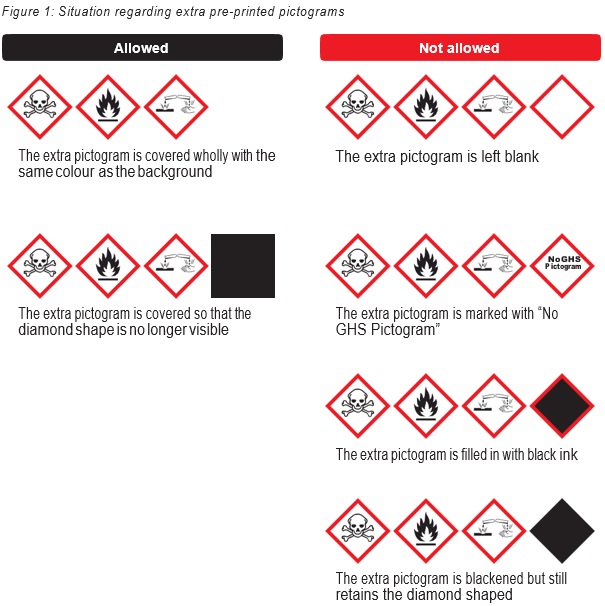- CONTACT US
- FAQ

GHS and CLASS
Abbreviation
| CBI | Confidential Business Information |
| CIMS | Chemical Information Management System |
| CLASS Regulations |
Occupational Safety and Health(Classification, Labelling and Safety Data Sheet of Hazardous Chemicals) Regulations 2013 |
| DOSH | Department of Occupational Safety and Health |
| GHS | The Globally Harmonised System of Classification and Labelling of Chemicals |
| ICOP CHC | Industry Code of Practice on Chemicals Classification and Hazard Communication |
| REACH | Registration, Evaluation, Authorisation & Restriction of Chemical |
| SDS | Safety Data Sheet |
| USECHH Regulations | Occupational Safety and Health
(Use and Standards of Exposure of Chemicals Hazardous to Health) Regulations 2000 |
General
DOSH has recognised training providers that are capable of providing training related to CLASS Regulations including classification, preparation of labelling and SDS. The list of training providers can be found at the link below:
CLASS Regulations applies to chemicals supplied for the use at a place of work. If retailers are supplying hazardous chemicals to place of work, the retailers need to comply with certain requirements of CLASS Regulations such as the requirements on packaging, labelling and SDS.
DOSH is responsible to enforce CLASS Regulations involving chemicals supplied for use at place of work only. Consumer sector is under the responsibility of Ministry of Domestic Trade and Consumer Affairs. However, if the consumer product is a chemical supplied for use at workplaces, it shall comply with CLASS Regulations.
CLASS Regulations is not applicable to forwarding/courier/freight company which only delivers and does not supply the chemicals for use at the workplace, regardless whether the company owns or rents a warehouse. However, if the workers in the warehouse handle chemicals hazardous to health, Occupational Safety and Health (Use and Standards of Exposure of Chemicals Hazardous to Health) Regulations 2000 (USECHH Regulations) is applicable.
Yes, manufacturer and/or importer of chemicals including for own consumption is responsible to comply with requirement on classification, packaging, labelling, SDS and inventory of hazardous chemicals.
The GHS building block for Malaysia is as specified in First Schedule of CLASS Regulations and building blocks which are not adopted by CLASS Regulations shall be excluded. Any building block which is not adopted by CLASS Regulations will result as “Not classified”.
Classification
Information about chemicals classification method can be referred to:
- Industry Code of Practice on Chemicals Classification and Hazard Communication, (ICOP CHC);
- The Globally Harmonized System of Classification and Labelling of Chemicals (GHS Purple Book)
If the chemical has already gone through the classification process and found to be not classified according to CLASS Regulations, the requirements of packaging, labelling, SDS and inventory of hazardous chemicals is not applicable to the particular chemical. However, the requirement of SDS is still applicable to the chemical mixture containing hazardous substance exceeding concentration specified in the Fifth Schedule of the CLASS Regulations. Please retain all classification record as proof of classification.
The format of classification record is given in paragraph 2.7 of Part 2 in the ICOP CHC. Classification record must contain all the information as per stated in the format. However, any form of documentation, for example electronic database or tools, which contains all of the specified information (as specified in the format) will be regarded as a classification record. Please be informed that an SDS is not a classification record.
Classification records are meant to prove that the chemicals are classified according to the CLASS Regulations with justifications and/or data to support the classification. These justifications and/or data are then ensured reliable through proper citations and are traceable when needed.
For chemicals not listed in Part 1, ICOP CHC, the principal supplier will have to carry out self-classification using methodology as detailed out in Part 2 of ICOP CHC. If the chemical has gone through the process of classification and the result for classification is “not classified” for all hazard classes, the requirements of packaging, labelling, SDS and inventory of hazardous chemicals is not applicable for that particular chemical. Please be informed that the list of chemicals in Part 1 only consist of substances and is not finite.
If the chemical is listed in Part 1 ICOP CHC, it is sufficient to mention that the chemical is listed in Part 1 ICOP CHC in the justification column (refer to Appendix 2.3 Classification Record).
Importer can obtain data on the classification from the overseas manufacturer. If the data could not be obtained, the importer will have to search data on the chemical from literatures, journals, established articles or internationally recognised chemical database in order to perform self-classification as per Part 2 of ICOP CHC. It is the duty of the importer to make classification record available for inspection.
The classification should be done based on the form of the product that it is supplied. Therefore, in this case, the classification should be done in solid form. If there is any known hazard that can affect health when handling/using the product, these should be detailed out and stated in the SDS (Section 2, as explained in the paragraph 3.7.2.3, ICOP and section 7).
The supplier should comply with the classification given in Part 1 ICOP CHC. If there is strong evidence or data available to support on the differences in classification, the supplier may submit evidence or data to the Department to highlight the inconsistency. The Director General will determine the final classification of the particular chemical.
Yes and this chemical is still classified as hazardous under CLASS Regulations.
Label
If the chemical is not classified as hazardous under the CLASS Regulations, the labelling need not be done as per required by the Regulations. However, classification and the record of classification shall be prepared and kept by the importer.
CLASS Regulations does not require translations to be made by certified translators as long as the meaning does not deviate from the original documents. It is the duty of the suppliers to ensure appropriate translation of SDS from English to Malay Language. DOSH is not providing any translation services. However, common terms and phrases such as hazard classification, hazard statement, precautionary statements and SDS headings shall be as specified in both languages in the Regulations and Industry Code of Practice on Chemicals Classification and Hazard Communication (ICOP CHC). This can facilitate translation process by the suppliers.
For imported products, the responsibility lies with the importer. The importer is to provide the packaging, SDS and label complying with CLASS Regulations when the product enters the place of work.
Extra pre-printed pictograms should be covered using the same colour as the label or blacked out entirely without showing the diamond shape. Examples of situations are given in Table 1

No. CLASS Regulations only allow the use of red border pictograms.
Yes. The identification of local supplier is mandatory to be included in the label and SDS.
Yes. All related hazard statements need to appear on the label unless there is evidence of duplication or redundancy. Where applicable, combined hazard statement in accordance with Third Schedule shall be used on the label.
- Storage tank – need label according to CLASS Regulations
- Pipeline – no labelling needed according to CLASS Regulations
- Tanker (during transportation) – may not need label according to CLASS Regulations
- Tanker (stationed at workplace) – need label according to CLASS Regulations
Maximum allowable precautionary statements on the label are 6 unless necessary to reflect the nature and severity of hazard.
Yes, but additional information is not considered in calculation of label size.
Each of the pictogram must be 1/15 of the surface of the label but must not be less than 100 mm². Surface of the label considered is the surface containing information as specified in subregulation 8 (1) & (2), CLASS Regulations.
There is no standard format that have been fixed but all the information as specified in subregulation 8 (1) & (2), CLASS Regulations must be included on the label.
Based on the provision of CLASS Regulations, the use of coloured background is acceptable but must not camouflage the text. However, the background of the pictograms must be white.
Yes, you can put two different company names on the label to provide details of the supplier. For example, the details of manufacturer and distributer/importer can both be on the label. The details of the local supplier is mandatory whereas the details of overseas manufacturer is optional.
Precautionary statements that shall be used must be as stated in ICOP CHC (Appendix 3.2 List of Precautionary Statements).
The information required in the SDS shall be in accordance with the minimum requirement as specified in Part 3 of the ICOP CHC (Paragraph 3.6). The REACH data can be used if it relates to the information required for the SDS.
Yes. It is the duty as importer (principal supplier) to prepare a CLASS Regulations’ compliant SDS in both languages.
No, DOSH does not provide any approval or certification to SDS and labelling. It is the duty of supplier to ensure their SDS and labelling is according to the CLASS Regulations and ICOP CHC.
Inventory
The requirement to prepare and submit an inventory is applicable to importer and/or manufacturer. Each hazardous chemical which is imported or manufactured in a quantity of 1 metric tonne (1000 kg) and above per year (1st January until 31st December) needs to be included in the inventory that needs to be submitted annually.
The inventory needs to be submitted by 31st March every year. The submission period is advised to be from 1st January until 31st March every year. It is advised that the importer/ manufacturer to submit the inventory as soon as possible to avoid congestion of the system.
It is advised that the importer/manufacturer submit the inventory using the system that can be reached using the following link: https://cims.dosh.gov.my/. To use this system, each importer/manufacturer for each premise will have to be registered with the system. Please be reminded that the CIMS is not a classification software, it is just a submission system.
As per Regulation 14 (3), CLASS Regulations, the inventory shall contain the following information:
- The product identifier;
- The name of the hazardous chemical;
- The composition and ingredients of a hazardous chemical;
- The hazard classification; and
- The total quantity of each hazardous chemical imported or supplied.
Any supplier which have been found not submitting or does not submit the inventory in time might be subjected to a penalty as per stated in the Regulations. No late submission will be entertained.
Local suppliers who obtained imported chemicals from other local suppliers are not considered as importers and therefore not required to submit inventory. Definition of importer in CLASS Regulations is only applicable for importers whom obtain supplies of chemicals directly from oversea.
Yes, only the composition and ingredient of a hazardous chemical in mixture have to be reported in the CIMS system.
Confidential Business Information (CBI)
Information that can be claimed as CBI on the SDS and inventory of hazardous is limited to:
- Name of a hazardous chemical
- The composition and ingredients of a hazardous chemical
No. Omission of the name of the hazardous chemical shall be replaced by generic name and the composition shall be replaced with a concentration range.
No, the generic name of chemicals as well as the allowable concentration range shall be obtained in Part 4 of the ICOP CHC.















